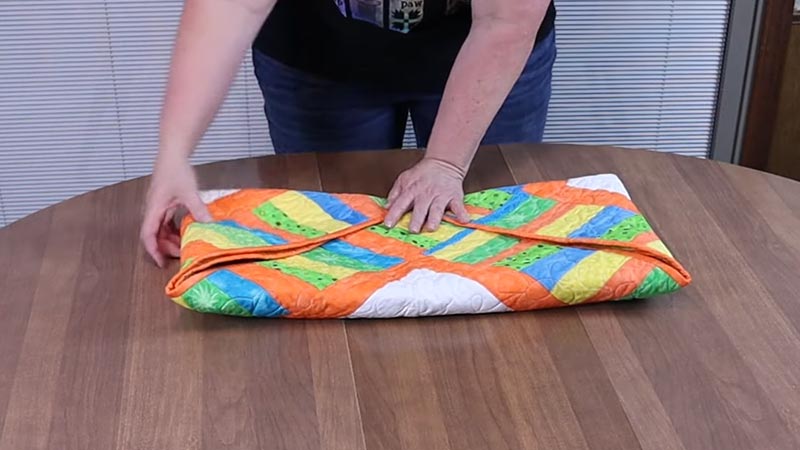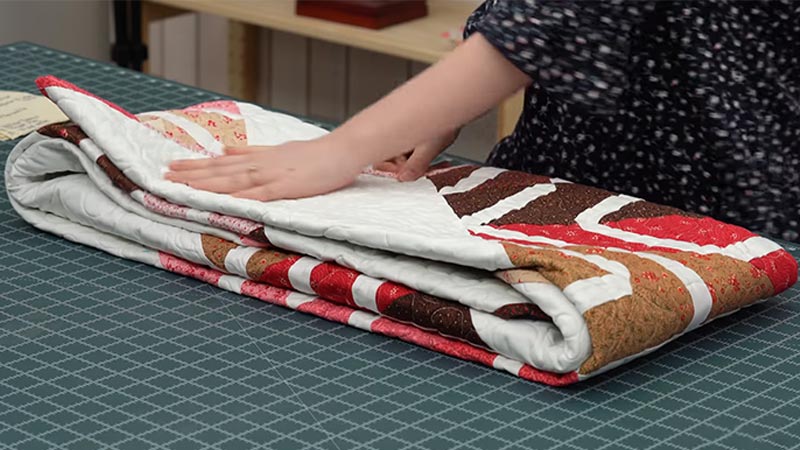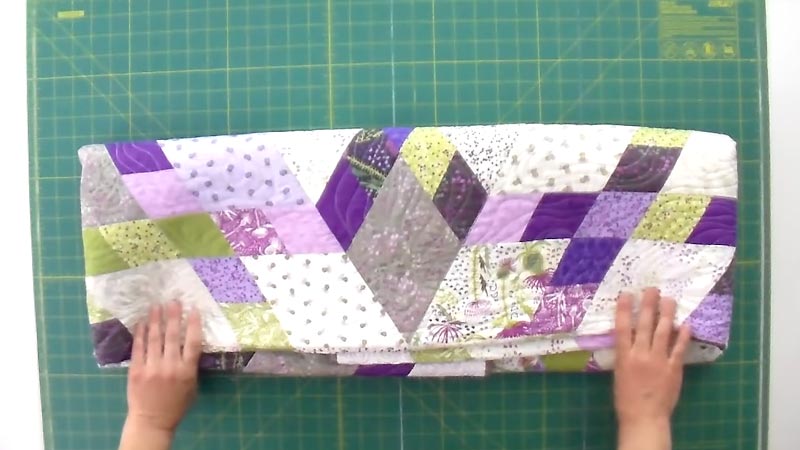The art of folding a quilt for storage is vital in preserving these cherished textile treasures. Whether a handmade masterpiece or a sentimental keepsake, proper folding ensures its longevity and aesthetic appeal.
This process involves more than just neatly arranging fabric; it’s about safeguarding against creases, dust, and environmental factors.
By following careful steps and considering the unique characteristics of your quilt, you can store it safely without compromising its quality.
This guide delves into the techniques and considerations that will help you fold your quilt carefully, ensuring it remains a source of warmth and beauty for years to come.

How to Fold a Quilt?
Folding a quilt properly is essential to keep it in good condition and make storage or display easier.
Follow these steps to fold a quilt neatly and efficiently:
Materials Needed:
- Clean, dry quilt
- Flat, clean surface
- Acid-free tissue paper
- Cotton sheet
Steps to Fold:
Prepare the Surface
Before you begin folding your quilt, choosing a clean and smooth surface is essential. Ensure that this surface is free from any dirt, dust, or debris that could transfer onto the quilt. You can use a bed, a large table, or any clean, flat area for this purpose.
Inspect the Quilt
Take a moment to inspect the quilt carefully. Ensure that it is clean and free from any stains, spills, or debris. If you notice any spots or stains, address them before folding.
Follow the care instructions provided for your quilt, which may include specific cleaning recommendations.
Smooth Out Wrinkles
Lay the quilt flat on your chosen surface. Gently smooth out any wrinkles or creases in the fabric. Be careful not to pull or tug on the quilt, as this can damage the delicate fibers. Use your hands to pat and smooth the fabric until it lies flat gently.
Fold in Half
To begin the folding process, fold the quilt in half lengthwise. Bring one edge of the quilt over to meet the other edge, ensuring that they align evenly. This step creates a long, narrow rectangle.
Fold in Half Again
Depending on the size of your quilt and available storage space, you may fold it in half once more. This optional step creates a smaller rectangle, making the quilt easier to manage and store. However, it’s entirely up to your preference.
Consider Tissue Paper
Consider using acid-free tissue paper when you plan to store the quilt for an extended period, especially if it holds sentimental or antique value.
Place a layer of tissue paper between the folded sections of the quilt. This helps protect the fabric and prevents any potential color transfer between layers.
Use a Cotton Sheet
Consider wrapping the folded quilt in a clean, white cotton sheet for added protection. This extra layer of fabric is a barrier against dust and light exposure, which can help preserve the quilt’s colors and quality over time.
Store in a Cool, Dry Place
Find a suitable storage location for your folded quilt. Ensure that this place is away from direct sunlight, extreme temperatures, and moisture. Avoid storing the quilt in a damp or humid environment, leading to mold and mildew growth.
Avoid Prolonged Folding
When storing the quilt for an extended period, consider periodically refolding it. Over time, prolonged folding can lead to permanent creasing in the fabric. By occasionally refolding the quilt differently, you can help prevent this issue.
Displaying the Quilt
When you intend to display your quilt, there are various options available. You can use a quilt rack or ladder or even frame it. These methods prevent stress on the fabric caused by prolonged folding and allow you to showcase your quilt’s beauty.
How to Store Your Quilt Safely?

Storing your quilt safely is essential to preserve its beauty and quality over time.
Here’s a step-by-step guide on how to store your quilt safely:
Clean Your Quilt
Before storing your quilt, it’s important to ensure that it’s in its best possible condition. Check for any dirt, stains, or odors.
Follow the care instructions provided with the quilt for cleaning. If needed, consider seeking professional cleaning services. Allow the quilt to air dry completely before proceeding.
Choose an Appropriate Container
Select a storage container that will provide a safe environment for your quilt. Look for options made of clean, breathable materials.
Acid-free storage boxes or containers designed specifically for textile preservation are highly recommended. Avoid using plastic bags or containers that can trap moisture, potentially leading to mildew or other forms of damage.
Prepare the Quilt
Lay your quilt on a clean, flat surface. Smooth out any wrinkles or creases gently. Take care not to pull or tug on the fabric, as this can lead to damage. Fold the quilt neatly, following a method that suits its size and shape.
Optionally, place acid-free tissue paper between the folds. This additional layer can help prevent any potential color transfer between quilt sections.
Add Protection Layers
For an extra layer of safeguarding, wrap your quilt in a clean, white cotton sheet. This sheet acts as a barrier against dust and light exposure, both of which can cause fading and other forms of damage to the fabric over time.
Store in a Cool, Dry Location
Find a suitable storage area that maintains a consistent, cool, and dry environment. Avoid places prone to extreme temperature fluctuations, such as basements or attics, and areas with high humidity levels. These conditions can lead to damage and deterioration over time.
Elevate the Quilt
Store the quilt on a raised surface, such as a shelf, rather than directly on the floor. This precaution helps prevent moisture from seeping into the quilt, which could lead to mold or mildew growth.
Check Regularly
Periodically inspect your quilt, especially if it’s stored for an extended period. Look for any signs of damage, pests, or mold. Early detection can help prevent further deterioration and allow for timely intervention.
Avoid Folding Stress
When possible, rotate how you fold the quilt each time you check on it. This simple action helps prevent permanent creases from forming in the same places over time.
Consider Display Options
When you wish to showcase your quilt, explore options like using a quilt rack, ladder, or wall hanger. These methods allow you to enjoy the quilt’s beauty without subjecting it to prolonged folding, which can potentially lead to creases.
Protect Against Pests
Utilize natural pest deterrents, such as cedar blocks or lavender sachets, in your storage area. These can help discourage insects from infesting your quilt.
Alternative Techniques for Folding Quilts for Storage

When it comes to storing quilts, there are various alternative folding methods that can help maximize space and minimize creases.
Here are some alternative techniques for folding quilts for storage:
Accordion Fold
Lay the quilt flat on a clean surface. Fold one edge over to meet the center, then fold the other edge over to meet the first fold. Continue folding in this accordion-like fashion until the quilt is a manageable size for storage.
This method minimizes the number of folds, reducing the risk of creasing and preserving the quilt’s integrity.
Square Fold
Lay the quilt flat on a clean surface. Fold it in half lengthwise, then fold it in half again, creating a square.
Repeat as necessary until the quilt is at your desired size for storage. This method creates a compact, square shape that can fit easily into storage containers or onto shelves.
Rolling Method
Lay the quilt flat on a clean surface. Starting from one end, gently roll the quilt towards the other end. Use a clean cotton sheet or muslin fabric to wrap the rolled quilt for added protection.
Rolling minimizes the number of folds, reducing the risk of creases. It’s also an excellent method for large quilts.
Hang the Quilt
Use a quilt hanger, drapery rod, or a sturdy wooden hanger with padded clips. Fold the quilt in half lengthwise and drape it over the hanger, ensuring it’s evenly distributed. Hanging the quilt avoids folds altogether, preventing creases and preserving the quilt’s integrity. It also serves as a decorative display.
Pillowcase Method
Lay the quilt flat on a clean surface. Fold the quilt in half lengthwise and insert it into a clean, cotton pillowcase. This method provides an extra layer of protection against dust and light exposure.
Tube Rolling
Lay the quilt flat on a clean surface. Roll it tightly from one end to the other, creating a tube-like shape. This method is ideal for smaller quilts with intricate patterns you want to preserve.
Tips for Specialty Quilts

Due to their unique materials, designs, or sentimental value, specialty quilts often require extra care and attention.
Here are some tips for handling and storing specialty quilts:
Silk or Delicate Fabric Quilts
Handle with clean, dry hands to avoid transferring oils or dirt to the delicate fabric. Store them flat or roll them in acid-free tissue paper to prevent creasing. Keep them away from direct sunlight, as silk can fade quickly.
Antique or Heirloom Quilts
Consult a textile conservator or professional quilt appraiser for advice on cleaning and storing valuable antique quilts. Store antique quilts in a cool, dry, and stable environment with controlled humidity to prevent deterioration.
Consider displaying them with UV-protected glass to shield them from light exposure.
Quilts with Embroidery
Ensure the embroidery threads or appliqué pieces are securely attached. Avoid excessive handling, as embroidery threads and delicate appliqué can be prone to damage. Store or roll them flat with acid-free tissue paper to protect the embellishments.
Art Quilts or Wall Hangings
Regularly use a lint roller or a soft brush to keep them clean and dust-free. Display them away from direct sunlight to preserve the vibrant colors.
Protect the back of the quilt with a clean backing fabric to prevent damage caused by friction against the wall.
Quilts with Specialized Fabrics
Store them away from direct sunlight to prevent fading. Consider washing them separately from other quilts, as some specialized fabrics may bleed color. Follow the care instructions provided with the quilt to maintain its unique characteristics.
Memory Quilts
Handle with care, as memory quilts often incorporate sentimental clothing or items. Store them in a cool, dry place to prevent mold or mildew growth. If the quilt includes fragile materials, such as baby clothing, avoid excessive washing to maintain their integrity.
Quilts with Heavy Beading
Store these quilts flat or rolled with extra padding to protect the beading and sequins.
Avoid hanging them, as the weight of the embellishments can cause damage over time. Handle them gently to prevent any beads or sequins from becoming loose.
Quilts with Unusual Shapes or 3D Elements
Store them with extra care, ensuring that any 3D elements are adequately supported and protected. Avoid folding if possible; instead, use a large storage container or a hanging solution.
Consult a Professional
When you are unsure about the best care and storage methods for your specialty quilt, consider seeking advice from a textile conservator or a quilting expert.
FAQs
How should I prepare my quilt before folding it for storage?
Before folding, ensure the quilt is clean and free of stains or debris. Smooth out any wrinkles or creases on a clean, flat surface.
Should I use any special materials when folding a quilt for storage?
Consider using acid-free tissue paper between folds, especially for long-term storage. A clean, white cotton sheet can also provide an extra layer of protection.
Is it better to roll or fold a quilt for storage?
Rolling is recommended for larger quilts or those with delicate fabrics to minimize creasing.
How often should I refold my stored quilt to prevent permanent creases?
It’s advisable to refold your quilt every six months if it’s stored for an extended period.
Are there any specific environmental considerations for storing a quilt?
Store your quilt in a cool, dry place away from direct sunlight, extreme temperatures, and moisture.
Wrap Up
Properly folding a quilt for storage is crucial in preserving its beauty and integrity.
By following careful techniques, such as smoothing out wrinkles, using protective layers like acid-free tissue paper, and choosing an appropriate storage location, you can safeguard your quilt from damage caused by folding.
Whether it’s an heirloom, specialty quilt, or a cherished memory, these steps ensure its longevity. Additionally, considering factors like fabric type and size allows for tailored care.
With diligence and attention to detail, your quilt will remain cherished, ready to be enjoyed for generations to come. Remember, periodic re-folding and avoiding environmental extremes further contribute to its lasting quality.
Leave a Reply